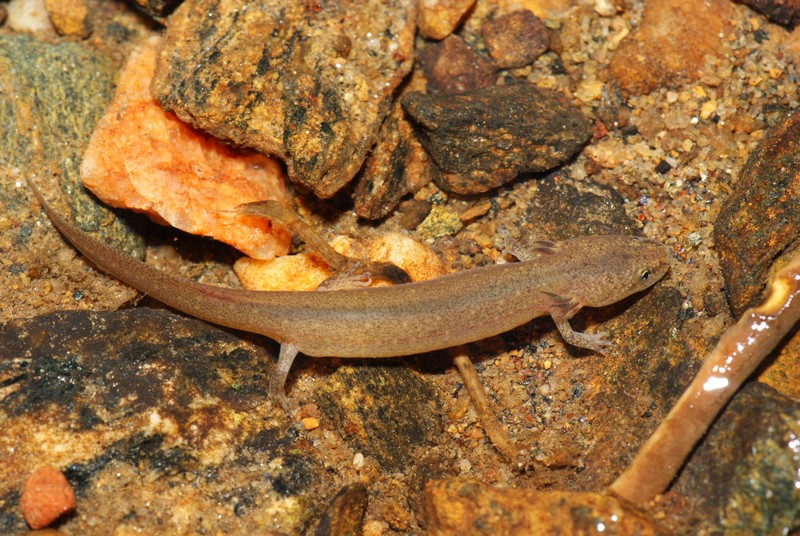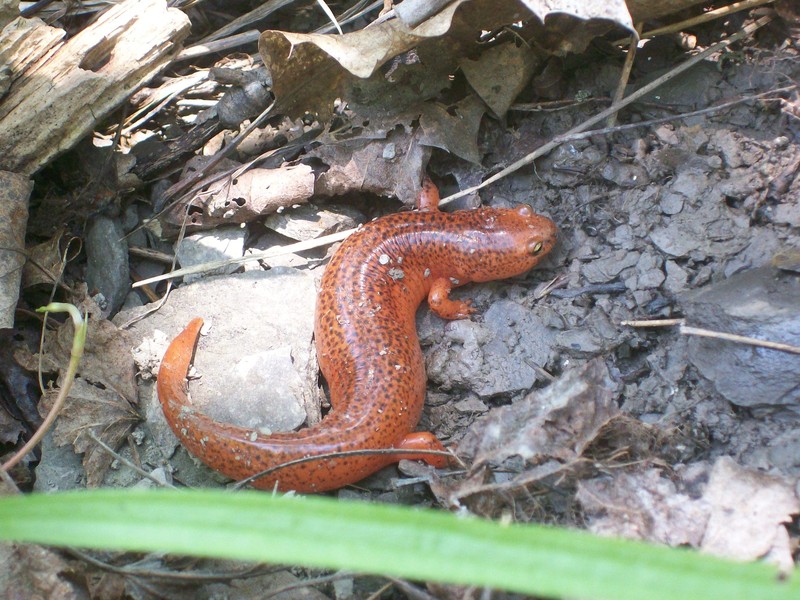Red Salamander
Pseudotriton ruber (Latreille,1801)
- Class
- Amphibia (Amphibians)
- Family
- Plethodontidae (Lungless Salamanders)
- State Protection
- Game with no open season
Defined as a Game species (other than birds) by New York State law, but there are no open seasons set and the species may not be hunted or taken at any time in New York.
- Federal Protection
- Not Listed
- State Conservation Status Rank
- S3S4
Vulnerable in New York, or Apparently Secure - Vulnerable to disappearing from New York (but not currently imperiled), with relatively few populations or locations, few individuals, and/or restricted range; or uncommon but not rare in New York; may be rare in some parts of the state; possibly some cause for long-term concern due to declines or other factors. More information is needed to assign either S3 or S4.
- Global Conservation Status Rank
- G5
Secure globally - Common in the world; widespread and abundant (but may be rare in some parts of its range).
Summary
Did you know?
The Red Salamander raises and waves its tail while hiding its head when threatened as a defense mechanism (O’Shea and Halliday 2001, Mitchell and Gibbons 2010). The bright coloration of most Red Salamanders, which produce toxic skin secretions, may also serve as a warning to predators (Jensen et al. 2008).
State Ranking Justification
During the New York State Department of Environmental Conservation Amphibian and Reptile Atlas (1990-1999), this species was reported from 38 topographic quadrangles in the lower Hudson Valley, west of the Hudson River, and the southern tier. Population stability is unknown in most areas, but is believed to be decreasing in the Lower Hudson-Long Island Bays watershed.
Short-term Trends
Red Salamander populations are likely stable (IUCN 2014, NatureServe 2020).
Long-term Trends
The long-term trend of Northern Red Salamanders is likely stable. Populations observed in the early 1900s (Bishop 1923, Myers 1929, Axtell and Axtell 1948) appear to still exist in more recent surveys (NYS DEC 2009).
Conservation and Management
Threats
Human activities around stream habitat can have a negative impact on Red Salamander habitat and populations. Siltation, runoff, stream acidiciation, and stream water temperature increases, caused by timbering, mining, road work, and urbanization, can threaten Red Salamander populations in New York (Mitchell and Gibbons 2010, Campbell Grant et al. 2014, Petranka 1998). Climate change also poses a threat to Red Salamanders, as it may cause water temperature increases and severe flooding that can alter the habitat.
Conservation Strategies and Management Practices
Management needs for the Red Salamander include minimizing pollution and conserving the habitat (Mitchell et al. 2006). Maintain or increase wetland connectivity through appropriate culvert design and reducing road crossings through streams. Silt, pollution, and runoff into wetlands and streams should be reduced or eliminated as well. Forest buffers around streams and wetlands should be created or maintained with native vegetation. Rocks, logs, and debris should be left in wetlands and surrounding forest.
Research Needs
The range of this species in New York needs to be confirmed. Some maps and researchers (IUCN 2014, Folt et al. 2016) reference a population on Long Island as well as in northern New York. Additional studies on how water quality affects populations (Campbell Grant et al. 2014), as well as movement patterns and territory sizes would be useful.
Habitat
Habitat
Northern Red Salamanders can be found in or near clear, cool running water, especially spring-fed streams in wooded or open areas (Conant 1975, IUCN 2014). In central New York adults spent most of the year beneath stones, sticks, and logs within 2 to 30 feet from the edge of the water (Axtell and Axtell 1948). They are associated with constantly flowing, cold spring water with stones, debris, and densely growing aquatic plants (Axtell and Axtell 1948). Females attach their eggs to the underside of submerged rocks, and larvae generally live in still pools of springs and streams (IUCN 2014).
Associated Ecological Communities
- Appalachian oak-hickory forest
(guide)
A hardwood forest that occurs on well-drained sites, usually on ridgetops, upper slopes, or south- and west-facing slopes. The soils are usually loams or sandy loams. This is a broadly defined forest community with several regional and edaphic variants. The dominant trees include red oak, white oak, and/or black oak. Mixed with the oaks, usually at lower densities, are pignut, shagbark, and/or sweet pignut hickory.
- Chestnut oak forest
(guide)
A hardwood forest that occurs on well-drained sites in glaciated portions of the Appalachians, and on the coastal plain. This forest is similar to the Allegheny oak forest; it is distinguished by fewer canopy dominants and a less diverse shrublayer and groundlayer flora. Dominant trees are typically chestnut oak and red oak.
- Oak-tulip tree forest
(guide)
A hardwood forest that occurs on moist, well-drained sites in southeastern New York. The dominant trees include a mixture of five or more of the following: red oak, tulip tree, American beech, black birch, red maple, scarlet oak, black oak, and white oak.
Range
New York State Distribution
The northern red salamander can be found in southern New York from the Hudson River west to southwestern New York, and south to Staten Island (NYS DEC 2009, Folt et al. 2016, Petranka 1998). Some maps indicate disjunct populations may exist in northern New York and on eastern Long Island (IUCN 2014, Folt et al. 2016), but there are no known recent observations to verify those populations.
Global Distribution
The Red Salamander ranges from New York west to eastern Ohio and southeastern Indiana, and south to Mississippi and the eastern tip of Louisiana (Folt et al. 2016). Northern Red Salamanders (Pseudotriton r. ruber) exist from New York south to the fall line of Alabama, Georgia and South Carolina, and west to Ohio, Kentucky, and central and eastern Tennessee. Blue Ridge Red Salamanders (P. r. nitidus) have a disjunct population in the Blue Ridge Mountains from the northern half of North Carolina and extreme southern Virginia and a spot in the Blue Ridge Mountains of Virginia near Roanoke. Black-chinned Red Salamanders (P. r. Schencki) range from the southern half of the Blue Ridge Mountains along the border of North Carolina and Tennessee into northeastern Georgia and western South Carolina. Southern Red Salamanders (P. r. vioscai) range from just below the fall line in South Carolina southwest into southern Alabama, eastern Mississippi, and eastern Tennessee. Red Salamanders are mostly absent from most of the Atlantic Coastal Plain (Folt et al. 2016).
Best Places to See
- Lower Hudson Valley
Identification Comments
Identifying Characteristics
Red Salamanders are approximately 11-15 centimeters long and are red or reddish orange and covered in black, irregular spots on the back that often run together (Conant 1975). These salamanders have yellow irises. The larvae are a pale brown with red gills, and sometimes with mottling on the skin (Mitchell and Gibbons 2010).
Characters Most Useful for Identification
The reddish coloring with yellow eyes and black spots distinguish this salamander from other species.
Best Life Stage for Proper Identification
Adult.
Behavior
Red Salamanders are nocturnal, and mostly spend their days within burrows or under litter or logs on the ground (O’Shea and Halliday 2001, Mitchell and Gibbons 2010). They spend their nights active above ground. Larvae and adults eat a variety of terrestrial and aquatic invertebrates, and other salamanders (Cecala et al. 2007, NatureServe 2020).
Best Time to See
Adults are mostly active from April through October (Axtell and Axtell 1948). Females lay a clutch of 50-100 eggs in the fall (Bruce 1972, Semlitsch 1983). Adults overwinter in or around streams.
- Present
- Active
- Reproducing
The time of year you would expect to find Red Salamander present, active, and reproducing in New York.
Similar Species
- Longtail Salamander (Eurycea longicauda)
(guide)
Longtail Salamanders also have spots, but have a much more slender body and a yellowish base color with distinct black markings on their long tail.
- Spring Salamander (Gyrinophilus porphyriticus)
Spring Salamanders can also be a reddish color, but the spots are fuzzy and indistinct.
Red Salamander Images
Taxonomy
Red Salamander
Pseudotriton ruber (Latreille,1801)
- Kingdom Animalia
- Phylum Craniata
- Class Amphibia
(Amphibians)
- Order Caudata
(Salamanders)
- Family Plethodontidae (Lungless Salamanders)
- Order Caudata
(Salamanders)
- Class Amphibia
(Amphibians)
- Phylum Craniata
Additional Resources
References
Axtell, Harold H. and Rachel C. Axtell. 1948. Pseudotriton ruber in Central New York State. Copeia 1:64
Bruce, Richard. 1972. The larval life of the red salamander, Pseudotriton ruber. Journal of Herpetology 6:43-51.
Campbell Grant, E. H., A. N. M. Wiewel, and K. C. Rice. 2014. Stream-Water Temperature Limits Occupancy of Salamanders in Mid-Atlantic Protected Areas. Journal of Herpetology 48(1):45-50.
Cecala, Kristen K., Steven J. Price, and Michael E. Dorcas. 2007. Diet of larval red salamanders (Pseudotriton ruber) examined using a nonlethal technique. Journal of Herpetology 41:741-745.
Conant, R. 1975. A field guide to reptiles and amphibians of eastern/central North America. Houghton Mifflin Company, Boston, Massachusetts. 429 pp.
Folt, Brian, Nicole Garrison, Craig Guyer, Juanita Rodriguez, and Jason E. Bond. 2016. Phylogeography and evolution of the Red Salamander (Pseudotriton ruber). Molecular Phylogenetics and Evolution 98:97-110.
IUCN SSC Amphibian Specialist Group. 2014. Pseudotriton ruber. The IUCN Red List of Threatened Species 2014: e.T59404A56253351. https://dx.doi.org/10.2305/IUCN.UK.2014-1.RLTS.T59404A56253351.en. Downloaded on 05 May 2020.
Jensen, John B., Carlos D. Camp, Whit Gibbons, and Matt J. Elliott. 2008. Amphibians and reptiles of Georgia. The University of Georgia Press, Athens, Georgia. 575 pp.
Mitchell, J.C., A.R. Breisch, and K.A. Buhlmann. 2006. Habitat management guidelines for amphibians and reptiles of the northeastern United States. Partners in Amphibian and Reptile Conservation, Technical Publication HMG-3, Montgomery, Alabama. 108 pp.
Mitchell, Joe and Whit Gibbons. 2010. Salamanders of the southeast. The University of Georgia Press, Athens, Georgia. 324 pp.
NatureServe. 2020. NatureServe Explorer: An online encyclopedia of life [web application]. Version 7.1. NatureServe, Arlington, Virginia. Available http://explorer.natureserve.org. (Accessed: April 24, 2020).
New York Natural Heritage Program. 2024. New York Natural Heritage Program Databases. Albany, NY.
New York State Department of Environmental Conservation. 2009. Herp atlas project. Albany, NY.
O’Shea, Mark and Tim Halliday. 2001. Reptiles and amphibians. Dorling Kindersley Limited, New York, New York. 256 pp.
Petranka, J. W. 1998. Salamanders of the United States and Canada. Washington and London: Smithsonian Institution Press.
Links
About This Guide
This guide was authored by: Ashley Ballou
Information for this guide was last updated on: June 29, 2020
Please cite this page as:
New York Natural Heritage Program. 2024.
Online Conservation Guide for
Pseudotriton ruber.
Available from: https://guides.nynhp.org/red-salamander/.
Accessed July 26, 2024.


